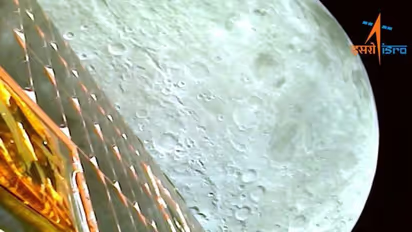Chandrayaan-1 data analysis illuminates origins of lunar water, say scientists

Synopsis
Earth's magnetosphere acts as a protective shield against space weathering and harmful solar radiation. The solar wind can reshape the magnetosphere, creating an extended tail on the night side.
New research, spearheaded by a planetary scientist from the University of Hawaii at Manoa (UH Manoa), Shuai Li, has led to a discovery with the potential to shed light on the origin of water ice detected in the lunar permanently shaded regions.
The research team conducted an analysis of remote sensing data gathered by Chandrayaan-1's Moon Mineralogy Mapper instrument. The University of Hawaii at Manoa stressed the importance of comprehending the concentration and distribution of water on the Moon for understanding its formation, evolution, and potential water resources for future human exploration. Their findings were published in Nature Astronomy.
According to UH Manoa, this significant research, spearheaded by Li, suggests that high-energy electrons in Earth's plasma sheet, a region containing trapped charged particles within Earth's magnetosphere, play a role in lunar surface weathering and may have contributed to the formation of water on the Moon.
Earth's magnetosphere acts as a protective shield against space weathering and harmful solar radiation. The solar wind can reshape the magnetosphere, creating an extended tail on the night side.
The plasma sheet within this magnetotail is a zone inhabited by high-energy electrons and ions, potentially originating from both Earth and the solar wind.
It is reportedly said that the scientists traditionally have primarily focused on the impact of high-energy ions on space weathering of celestial bodies, including the Moon. Solar wind, composed of high-energy particles like protons, bombards the lunar surface and is believed to be a key factor in the formation of lunar water.
Building upon his earlier research, which demonstrated that oxygen from Earth's magnetotail is causing iron on the Moon's polar regions to rust, Li, an assistant researcher at the UH Mānoa School of Ocean and Earth Science and Technology, set out to investigate how surface weathering changes as the Moon passes through Earth's magnetotail.
This region provides significant shielding against solar wind but not against solar photons, allowing it to impact lunar surface processes.
Stay updated with the Breaking News Today and Latest News from across India and around the world. Get real-time updates, in-depth analysis, and comprehensive coverage of India News, World News, Indian Defence News, Kerala News, and Karnataka News. From politics to current affairs, follow every major story as it unfolds. Get real-time updates from IMD on major cities weather forecasts, including Rain alerts, Cyclone warnings, and temperature trends. Download the Asianet News Official App from the Android Play Store and iPhone App Store for accurate and timely news updates anytime, anywhere.